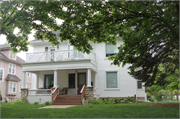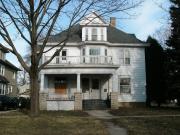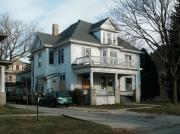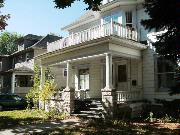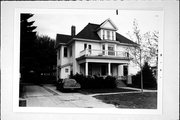Property Record
159 N MAPLE AVE
Architecture and History Inventory
| Historic Name: | A.W. Moody House |
|---|---|
| Other Name: | |
| Contributing: | |
| Reference Number: | 2181 |
| Location (Address): | 159 N MAPLE AVE |
|---|---|
| County: | Brown |
| City: | Green Bay |
| Township/Village: | |
| Unincorporated Community: | |
| Town: | |
| Range: | |
| Direction: | |
| Section: | |
| Quarter Section: | |
| Quarter/Quarter Section: |
| Year Built: | 1900 |
|---|---|
| Additions: | |
| Survey Date: | 198520172021 |
| Historic Use: | house |
| Architectural Style: | Colonial Revival/Georgian Revival |
| Structural System: | Unknown |
| Wall Material: | Aluminum/Vinyl Siding |
| Architect: | George F. Barber |
| Other Buildings On Site: | |
| Demolished?: | No |
| Demolished Date: |
| National/State Register Listing Name: | Not listed |
|---|---|
| National Register Listing Date: | |
| State Register Listing Date: |
| Additional Information: | City of Green Bay, Wisconsin - Architectural and Historical Intensive Survey Report Phase 1 - 2021 Photo code #2: 75BR-7/29 Early, very large example: Pedimented dormers face north, south, east and west. Main frieze has a denticulated molding above, as does the frieze of the front porch. The north facade has two, one-story tall hip roof rectilinear bays. The two-third width front porch is supported by three fluted Doric Order columns with fluted engaged columns double the end columns. 2017 -- The house at 159 N. Maple was built in 1900 for the Moody family. A. W. Moody was notable for his involvement with the Alart & McGuire pickle enterprise, and his family lived at the house until 1907. J. T. Phillips, owner from 1907 through 1912, was the manager of the Diamond Lumber Company. L. J. Patterson, a prominent dentist, called 159 N. Maple home from 1912 to sometime between 1918 and 1923 (c. 1920). Mr. Patterson was a director for more than one local business, and in this role he found himself on the wrong side of the law in 1926 (violation of 18th Amendment). E. P. Boland owned the house from c. 1920 through 1943 or later. Mr. Boland, at age 26, was elected to the Green Bay city council in 1912 (and again in 1914), making him the youngest person to serve as a Green Bay alderperson up to that time. There is a very high likelihood that the house was designed by the George F. Barber firm in Knoxville, Tennessee ("The plans were drawn by a Knoxville, Tenn., firm of architects who have planned some of the finest residences in the country" - GB Press-Gazette, June 1900) . A newspaper article from the time of its construction references a Knoxville architect and the design is very similar to a number of Barber’s Colonial Revival offerings. In its As-Built condition, 159 North Maple had a full-width front porch, as noted on the Sanborn Maps. The front porch was narrowed to its current 2/3 width sometime between 1932 and 1936. Other notable changes during this time were the addition of a one-car garage between 1917 and 1932 and changes to the rear of the house (small kitchen addition and removal of a rear/kitchen porch) between 1932 and 1936. |
|---|---|
| Bibliographic References: | A. Brown County Tax Rolls B. Green Bay Press-Gazette, 1 June 1900, page 9; repeated 6 June 1900, page 5 C. City Directories D. Sanborn Maps &/or Sanborn Map updates for 1900, 1907, 1917, 1932, 1936 |
| Wisconsin Architecture and History Inventory, State Historic Preservation Office, Wisconsin Historical Society, Madison, Wisconsin |

